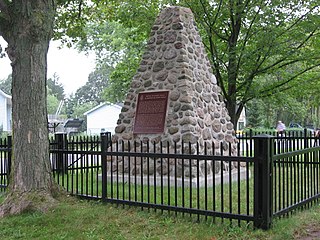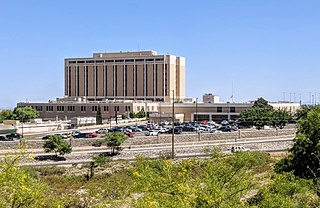
Abner Doubleday was a career United States Army officer and Union major general in the American Civil War. He fired the first shot in defense of Fort Sumter, the opening battle of the war, and had a pivotal role in the early fighting at the Battle of Gettysburg. Gettysburg was his finest hour, but his relief by Maj. Gen. George G. Meade caused lasting enmity between the two men. In San Francisco, after the war, he obtained a patent on the cable car railway that still runs there. In his final years in New Jersey, he was a prominent member and later president of the Theosophical Society.

The Distinguished Service Medal (DSM) is a military decoration of the United States Army that is presented to a soldier who has distinguished themselves by exceptionally meritorious service to the Government in a duty of great responsibility. The performance must be such as to merit recognition for service that is clearly exceptional. The exceptional performance of normal duty will not alone justify an award of this decoration.

A general officer is an officer of high rank in the armies, and in some nations' air forces, space forces, or marines.

Military ranks are a system of hierarchical relationships in armed forces, police, intelligence agencies or other institutions organized along military lines. The military rank system defines dominance, authority, and responsibility in a military hierarchy. It incorporates the principles of exercising power and authority into the military chain of command – the succession of commanders superior to subordinates through which command is exercised. The military chain of command constructs an important component for organized collective action.

A brigade is a major tactical military formation that is typically composed of three to six battalions plus supporting elements. It is roughly equivalent to an enlarged or reinforced regiment. Two or more brigades may constitute a division.

The United States Army Pacific (USARPAC) is an Army Service Component Command (ASCC) of the United States Army and is the army component unit of the United States Indo-Pacific Command. The main areas that this command has jurisdiction in include Hawaii, Alaska, the Pacific Ocean, South Korea and Japan. It also performs missions in Southeast Asia, in the countries stretching from the Philippines all the way to Bangladesh and India. United States Forces Korea (USFK) has operational command and control on US Forces in Korea since January 2012, and USARPAC headquarters oversees the manning, training, and equipping of US Army forces assigned to USFK.

The Distinguished Flying Cross (DFC) is a military decoration of the United States Armed Forces. The medal was established on July 2, 1926, and is currently awarded to any persons who, after April 6, 1917, distinguish themselves by single acts of heroism or extraordinary achievement while participating in aerial flight. Both heroism and extraordinary achievement are entirely distinctive, involving operations that are not routine. The medal may be awarded to friendly foreign military members in ranks equivalent to U.S. Pay Grade of O-6 and below, in actual combat in support operations.

The Distinguished Service Cross (DSC) is the United States Army's second highest military decoration for soldiers who display extraordinary heroism in combat with an armed enemy force. Actions that merit the Distinguished Service Cross must be of such a high degree that they are above those required for all other U.S. combat decorations, but which do not meet the criteria for the Medal of Honor. The Army Distinguished Service Cross is equivalent to the Navy and Marine Corps' Navy Cross, the Air Force and Space Force's Air Force Cross, and the Coast Guard Cross. Prior to the creation of the Air Force Cross in 1960, airmen were awarded the Distinguished Service Cross.

The Walter Reed Army Medical Center (WRAMC) – known as Walter Reed General Hospital (WRGH) until 1951 – was the U.S. Army's flagship medical center from 1909 to 2011. Located on 113 acres (46 ha) in the District of Columbia, it served more than 150,000 active and retired personnel from all branches of the military. The center was named after Major Walter Reed (1851–1902), an Army physician who led the team that confirmed that yellow fever is transmitted by mosquitoes rather than direct contact.

I Corps was the designation of three different corps-sized units in the Union Army during the American Civil War. Separate formation called the I Corps served in the Army of the Ohio/Army of the Cumberland under Alexander M. McCook from September 29, 1862 to November 5, 1862, in the Army of the Mississippi under George W. Morgan from January 4, 1863 to January 12, 1863, and in the Army of the Potomac and Army of Virginia. The first two were units of very limited life; the third was one of the most distinguished and veteran corps in the entire Union Army, commanded by very distinguished officers. The term "First Corps" is also used to describe the First Veteran Corps from 1864 to 1866.

The Field Artillery Branch is a combat arms branch of the United States Army.

The Battle of Cook's Mills was the last engagement between U.S. and British armies in the Niagara, and the penultimate engagement on Canadian soil during the War of 1812. After about a half-hour, American forces out-maneuvered the British column and destroyed all grain and flour.

In the United States Army, Marine Corps, and Air Force, major is a field grade military officer rank above the rank of captain and below the rank of lieutenant colonel. It is equivalent to the naval rank of lieutenant commander in the other uniformed services. Although lieutenant commanders are considered junior officers by their respective services, the rank of major is that of a senior officer in the United States Army, the United States Marine Corps, and the United States Air Force.

The Tidal Basin is a partially man-made reservoir between the Potomac River and the Washington Channel in Washington, D.C. It is part of West Potomac Park and is a focal point of the National Cherry Blossom Festival held each spring. The Jefferson Memorial, the Martin Luther King Jr. Memorial, the Franklin Delano Roosevelt Memorial, and the George Mason Memorial are situated adjacent to the Tidal Basin. The basin covers an area of about 107 acres (43 ha) and is 10 feet (3.0 m) deep.

In the United States Armed Forces, a lieutenant general is a three-star general officer in the United States Army, Marine Corps, Air Force, and Space Force.

William Beaumont Army Medical Center is a Department of Defense medical facility located in El Paso, Texas. It provides comprehensive care to all beneficiaries including active duty military, their family members, and retirees. The hospital is located in the Central/Northeastern part of El Paso. and provides emergency department services for Northeast El Paso.

United States Army Officer rank insignia in use today.

Albert Leopold Mills was a United States Army Major General who was a recipient of the Medal of Honor for valor in action on July 1, 1898, near Santiago, Cuba. An 1879 graduate of West Point, he served in the Army until his death in 1916. Following his service in Cuba, he was appointed Superintendent of West Point, jumping in rank from First Lieutenant to Colonel. His final posting was as the Chief, Division of Militia Affairs, a precursor to the National Guard Bureau.
Tacketts Mill is an unincorporated community in Stafford County, in the U.S. state of Virginia.
Major general is a military rank used in many countries. It is derived from the older rank of sergeant major general. The disappearance of the "sergeant" in the title explains the apparent confusion of a lieutenant general outranking a major general, whereas a major outranks a lieutenant.

















